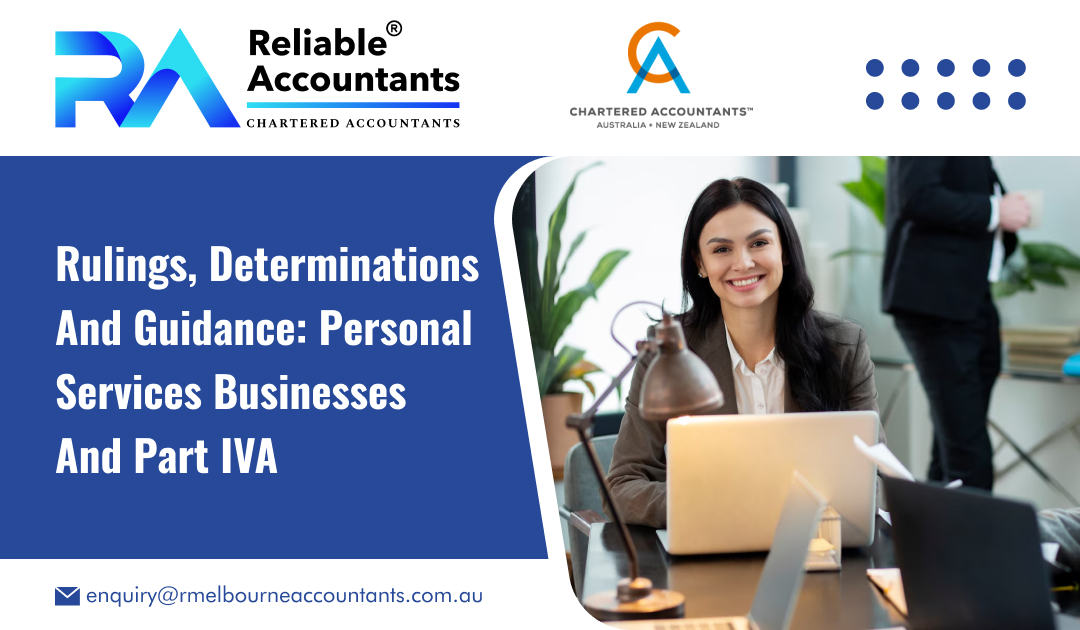Personal services businesses and Part IVA
The Australian Taxation Office (ATO) has released a draft practical compliance guideline outlining its approach to applying the general anti-avoidance rules in Part IVA to situations where personal services income (PSI) is earned through a personal services entity (PSE) engaged in a personal services business (PSB). This guideline is aimed at taxpayers who are generating PSI through an intermediary entity, such as a company or trust, and the PSI attribution rules do not apply because the entity meets the criteria to be classified as a PSB.
The Australian Taxation Office (ATO) has a consistent perspective that if a company or trust is used to earn Personal Services Income (PSI), the net profits from this activity should generally be taxed in the hands of the individual performing the work, even if the PSI tests are met. If any profits are distributed to related parties or retained in a company to benefit from a lower tax rate, there is a risk that Part IVA could be applied to cancel the tax advantage.
The draft PCG provides specific indicators of arrangements that the ATO considers “low-risk” and “higher-risk,” along with examples of such arrangements. For instance, if the entire income from personal services is paid to the individual who performed the work and is taxed at their own marginal rate, this arrangement is likely to be low-risk and may not be reviewed by the ATO.
If the amounts paid to related parties for administrative work are not excessive, then arrangements can still be classified as low-risk. If an amount is retained in a company to buy business assets in the short term, an arrangement could be low-risk.
Arrangements will be considered higher risk if an individual receives a tax benefit by distributing some of the net PSI (personal services income) profit to another entity, resulting in a lower overall tax rate. The draft PCG (Practical Compliance Guideline) also gives an example where a business is operated through a company with historical tax losses and the full net PSI profit for the current year isn’t paid out to the individual, showing that this would be a higher-risk scenario. These higher-risk arrangements are more likely to be reviewed by the ATO (Australian Taxation Office).
It’s important to understand that just because an arrangement is classified as higher-risk, it won’t automatically trigger the application of Part IVA (section of the Income Tax Assessment Act dealing with anti-avoidance provisions). The draft PCG explains scenarios that are more likely to be reviewed by the ATO because Part IVA may be applicable.
Guide to employee expenses updated
The ATO has updated its “Employees guide for work expenses” which aims to help employees to check if an expense is deductible, how to approach claimed expenses, how to portion expenses that are not deductible wholly, and to help employees understand the substantiation requirements for work expenses. In the PCG, the ATO notes that individuals who meet certain requirements can claim deductions using the electric vehicle charging rate of 4.20 cents per kilometre.
GST and sunscreen
At a high level, supplies of products that have sunscreen are GST-free if the product has the following four attributes:
- It is a sunscreen preparation for dermal application
- It has a SPF of 15 or above
- It must be included in the Australian Register of Therapeutic Goods (ARTG) under the Therapeutic Goods Act 1989 (TGA), and
- It is advertised for use as a sunscreen.
Applying the rules gets trickier with sunscreen products that have extra features besides just sun protection. To figure out if the product is mainly sold as sunscreen, you need to look closely at its labelling and packaging. These details help create a clear picture of the product’s main purpose.
Other factors for checking a product’s primary use include the product’s name, descriptions, sizing and ordering of marketing content on labels and packaging, and how the product is advertised, the overall impression of the product depending on marketing, product placement, etc.
Fine-tuning promoter penalty laws
PS LA 2021/1 discusses the application of promoter penalty laws in Division 290 of Schedule 1 to the Taxation Administration Act 1953 and section 68B of the Superannuation Industry (Supervision) Act 1993 (SISA). These laws were initially designed to discourage the promotion of tax exploitation schemes and have recently been updated to help the ATO target promoters.
The ATO has made some updates to the existing indicators of promoter behaviour that could lead to referral to the Promoters Program. This includes adding specific references to schemes involving early access to superannuation. Additionally, the ATO has introduced a new indicator for schemes claiming to comply with an ATO ruling, with a significant difference between the scheme and the ATO ruling.
Draft excise determination for spirits
Excise Determination 2024 specifies the maximum quantities of spirit that some classes of individuals can use for industrial, scientific, manufacturing, medical, educational or veterinary purposes, without paying duty. The classes of individuals covered are veterinary practitioners, health care practitioners, government-related entities, medical institutions, and education institutions.
The determination will start from 1 January 2025. If implemented, this must minimise the compliance burden for affected entities that must make applications to the ATO for approval to use up to the specified quantity of spirit without paying duty.

